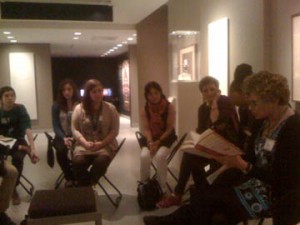I recently traveled to Houston (as you may know, from other posts), where the American Association of Museums (AAM) annual conference took place. This year’s conference focus was The Museum of Tomorrow. I got to thinking about this focus after a great session the first day of the conference, especially as it pertains to my work at the Rubin. Lois Silverman, whom I’ve mentioned before, led “Changing Relationships, Changing the World: Applying the Social Work of Museums,” joined by Heidi Brinig (Providence Children’s Museum) and Karleen Gardner (Memphis Brooks Museum of Art). Lois has expanded my view about the importance of museums in the social and cultural fabric of life, especially for people who are marginalized or otherwise shut out of opportunities to engage in society. This is a role some museums have a hard time embracing, but I feel incredibly fortunate to work in a place where we are not only expected to engage new audiences, but also to think outside the box about how and why we engage with them.
As a perfect example of the museum “social work” Lois describes, just last month I’ve started a training series for staff guides and volunteer docents in collaboration with the Alzheimer’s Association, NY Chapter and Arts & Minds. We are preparing to launch a program for people with dementia and their caregivers later this summer. We’re calling it Mindful Connections, and in the preparation process, we are all reflecting on the disease, its subsequent effects and impacts, and the role our art can play in providing a space for people to connect. It is the social aspect of these kinds of programs that is so valuable for families of people with dementia. I can attest to this, on a personal level. My grandfather had Alzheimer’s disease before he passed away last year, and as the disease progressed, his interaction with the outside world diminished in equal parts. My grandfather loved going out to his favorite restaurants each week, for as long as I can remember. He had a booming voice, and I remember fondly all the times he joked with waiters and waitresses, laughing loudly alongside my family when we all went out together. There came a time, though, when my parents and grandmother stopped taking him out, because of the kind of comments he made or the disorientation of being in unfamiliar spaces. I only wish I had the experience of programs like our Mindful Connections then! He would have loved to look at art and talked about what he saw-felt-remembered! And, even more importantly, he would have loved the chance to connect with people socially, be out in the world, and comfortably in a space where he could be himself.
Alas, that opportunity has passed, but a new one is here now, and I am so thrilled for the thoughtfulness and introspection that is infused among our group of staff educators and volunteer docents. We have one more training session with the Alzheimer’s Association and Arts & Minds, and I look forward to taking the next steps to get our program underway. This program is a piece of our museum of tomorrow, where every visitor can find a connection with our artwork and each other.



